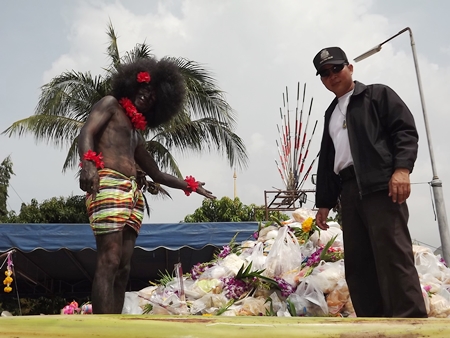Southern Thais celebrated a local version of their biggest event of the year, as they gathered in Pattaya for the Tenth Lunar Month Festival.
Chonburi Deputy Gov. Rewat Phonlookin, Nongprue Mayor Mai Chaiyanit and Somsin Thipmanee, president of Chonburi Southern People Association opened the cultural-preservation event Oct. 15 at Bunyakanchanaram Temple.
The festival was first held in 1923 in Nakhon Si Thammarat. The ceremony has since become an annual event. Besides traditional activities the three days and nights of the festival includes trade fairs and performances. The celebration was originally the idea of Thais who wanted to pay respects and offer merit to their ancestors. As a result, this practice became the most important and biggest event in Nakhon Si Thammarat.
 The food used in the ceremony is distributed to local villagers, known as the Ching Pret ceremony.
The food used in the ceremony is distributed to local villagers, known as the Ching Pret ceremony.
Harvest season generally falls during the 10th lunar month, a time when southern Thais traditionally offer their products to the spirits of their ancestors, particularly ones that have not yet reincarnated. They believe these spirits will be released from the underworld, so the living make merit by giving food offerings to Buddhist monks and dedicate merit to the dead.
The merit making starts on the first day of the festival. Fifteen days from this day the spirits of the dead will go back to the underworld. The people then arrange a merit making ceremony again on the last day of the festival, to which most people attend.
The villagers take the 13th day as the day to buy food, cook, and arrange in sets to offer to monks on the next day. Sets of food offerings are usually laid on a short bamboo basket, added to other items used by monks. The set requires five major Thai snacks. The first is Phong, representing a vehicle that will take the spirits to heaven. The second is La, as clothing for the dead, and thirdly, Kong as an accessory. The forth is Di Sam, believed to be used as money by the dead. And finally, Ba snack, given to the dead as a tool for playing on Songkran day. However, the elderly believe that there is another snack needed to be put in. It is La Loy, acting as a bed and a pillow for the spirits. Most of these items are dried snacks that can be kept for a long time.
Following giving food offerings to monks, the people hold a ceremony to give alms to Pret, a hungry ghost with a thin tall body. Foods and snacks are put on a high post so that Prets can reach them. Then the monks pray to call for the ghosts. After the ceremony, poor villagers or children will rush to snatch the foods and snacks, commonly known as the Ching Pret ceremony.
Besides a usual merit making ceremony of the local people, the provincial authorities organize a procession of food offerings in the city, plus governmental exhibitions, and an OTOP fair. There are also cultural shows and performances during the festival.







